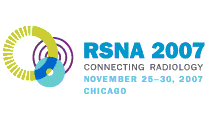
Abstract Archives of the RSNA, 2007
LL-NR4056-H10
Differentiate Cerebral Ischemia Disease from Multiple Sclerosis by Using Diffusion Tensor Magnetic Resonance Imaging
Scientific Posters
Presented on November 27, 2007
Presented as part of LL-NR-H: Neuroradiology/Head and Neck
Lou Xin MD, Presenter: Nothing to Disclose
Ma Lin MD, Abstract Co-Author: Nothing to Disclose
Li Xuemei MD, Abstract Co-Author: Nothing to Disclose
Cai Youquan MD, Abstract Co-Author: Nothing to Disclose
It is difficult to differentiate cerebral ischemia disease form early multiple sclerosis (MS) only by routine magnetic resonance images. Diffusion tensor magnetic resonance imaging (DTI) are abnormal in patients with established MS. The objective of this study was to assess the feasibility of DTI in the differentiation between the patients with cerebral ischemia disease and early MS.
During an 8 month period, MR scans were acquired for all subjects on a 1.5T scanner (General Electric Echospeed, Milwaukee, WI) using 8 channel head coil. Thirty-two patients with cerebral ischemia disease and eighteen patients with clinical diagnosed MS who have relatively short disease duration (mean = 2.7 years) had routine MR pulse sequences performed including axial T1-weighted (TR/TE=2416ms/14ms), axial fast spin echo T2-weighted (TR/TE=4660ms/111ms). The DTI was obtained using a single shot, multi-slice spin-echo echo planar diffusion tensor pulse sequence (TR/TE=10000/83.6ms, 35 slices, FOV 24cm, matrix 128×128, slice thickness 3mm, interleaved data acquisition). Using the diffusion maps, the Fractional anisotropy (FA) value of the genu, splenium, body of the corpus callosum, and the white matter of the frontal and occipital lobe were measu
The FA value was decreased obviously in the anterior and posterior body and splenium of the corpus callosum(p<0.001,t=3.443; p=0.003,t=2.281 and p=0.011,t=1.846)in the MS patients compared with the cerebral ischemia disease patients, but had no significant difference at the genu, the white matter of the frontal and occipital lobe of the two groups.
The Wallerian degeneration of the corpus callosum in the MS patients is significant because of the decreased FA value, and DTI can no noninvasive detect the potential disorder of corpus callosum in vivo, thus providing useful information to differentiate the cerebral ischemia disease from multiple sclerosis.
DTI using a region of interest approach may be sensitive in the differentiation between the patients with cerebral ischemia disease and early MS.
Xin, L,
Lin, M,
Xuemei, L,
Youquan, C,
Differentiate Cerebral Ischemia Disease from Multiple Sclerosis by Using Diffusion Tensor Magnetic Resonance Imaging. Radiological Society of North America 2007 Scientific Assembly and Annual Meeting, November 25 - November 30, 2007 ,Chicago IL.
http://archive.rsna.org/2007/5003213.html

